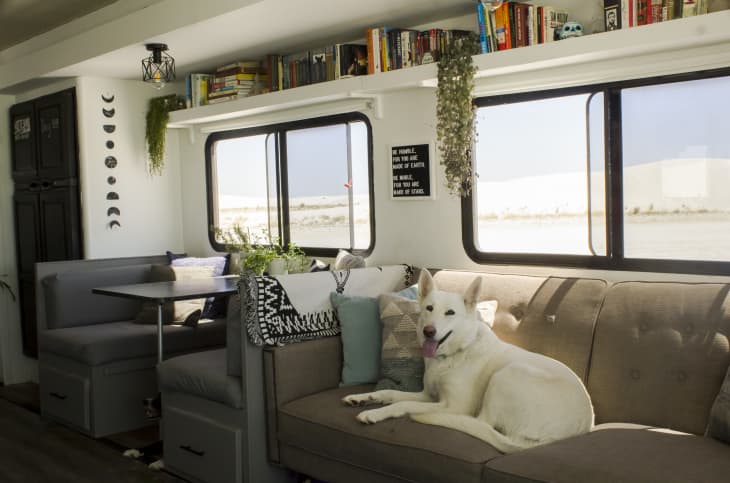Genius Tips From a Couple Who Keeps 95 Plants Alive—In 300 Square Feet

It’s impressive enough that Samantha and Brendan Binger were able to fit their stuff, three dogs, and two cats in their home RV… and make the space look warm, lovely and homey. But did you notice all those plants?! Sam says there are an amazing 95 plants present (and that’s NOT including “all the succulents packed into terrariums”). Being able to keep 95 plants happy and healthy in a tiny, MOVING home signifies a plant master in my book, so I asked her for some plant care tips, both for mobile and stationary homes!
Apartment Therapy: What plants work best?
Samantha Binger: This has taken quite a bit of trial and error to determine, but we’ve found that cacti, succulents, and snake plants work best for our lifestyle. Pothos and philodendron variety plants are also great because they are low-light compatible and low-maintenance.
AT: How do they not fall over and get jostled around?
SB: When we pack up to move to a new location, ninety percent of the pack-up is moving plants around. Some plants are packed into our sinks, some are packed into boxes, and others just stay where they are depending on the location. We had a few mishaps in our first couple months of traveling, but all the plants have since traveled safely and securely for the past year or so.
“I would suggest doing research on the plants you are interested in before buying them, to avoid unnecessary waste.”
AT: Any tips for caring for plants on the move?
SB: The biggest challenge with plant care on the move is the changing climates. Since humidity is constantly changing, it is difficult to have a set schedule for watering. It can also be difficult to keep our tropicals happy if the humidity is too low. To combat these issues, we have a mini-humidifier in the same window as all of our tropical plants (in our bedroom), to give them consistent conditions, and we also have a device that tests the moisture of the soil so we know the best time to water. Without these, I’m not sure we could successfully keep tropical plants on the road.
AT: Doesn’t the sun change and affect the plants?
SB: When we move, the position of the sun also changes, which can be a bit of a challenge. Because of the way our solar panels are set up, we generally park with our front window receiving the most sun. This window can receive full sun anywhere from four to 10 hours per day, so this is where we store all of our sun-loving plants, such as our cacti and succulents. Our bedroom plant window is home to all of our low-light and tropical plants, so we are sure to keep the shade closed during the sunniest part of the day to avoid burning. We leave it open when there is indirect sunlight coming through, since this is the type of light that causes tropical plants to thrive.
AT: Any plant care/buying tips for small spaces? (mobile or not)
SB: I would suggest doing research on the plants you are interested in before buying them, to avoid unnecessary waste. We generally avoid any plants that are listed as difficult to care for, since we know these will most likely be even harder to care for in the RV.
We also utilize the various tools mentioned above (humidifier, moisture-tester) to make sure that our plants are being properly watered. Lastly, we prefer to buy plants from small and local nurseries, as they tend to be higher quality. We have purchased several sick plants from Lowe’s and Home Depot, which ended up infecting other plants. When we buy from a garden center or a nursery, we generally know that we are getting a quality plant that was well-cared for prior to purchase.